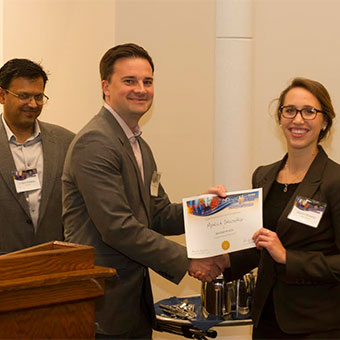
Hope chemistry major Monica Ohnsorg has finished second in the country in the 2015 NDConnect national undergraduate nanotechnology research competition.
She was one of only 14 semifinalists from across the U.S. chosen to compete during the day-long event at the University of Notre Dame on Friday, Oct. 23, and was the only semifinalist to have conducted research at a primarily undergraduate institution instead of a research university. A senior from Chanhassen, Minnesota, who was also a semi-finalist last year, Ohnsorg was honored for her investigation “Understanding fundamental metal-organic thin film growth to further integration into applied devices.”
“Monica is an incredibly capable and motivated research student,” said Dr. Beth Anderson, Ohnsorg’s research mentor, who is an assistant professor of chemistry and Towsley Research Scholar at Hope. “She is an author on two research publications—first author on one of them—and recipient of multiple external research awards. She is excited by opportunities to share her new research findings.”
The award reflects ground-breaking original research and is a tremendous external affirmation of the high level of work at the college, but Ohnsorg particularly values the broader lessons that she has learned during the three years in which she has been involved in collaborative research at Hope.
“Some people call Hope a graduate school for undergraduates, and in terms of the research quality it is very true,” said Ohnsorg, who anticipates continuing her education in graduate school and pursuing a career in nanobiotechnology, researching nanomaterials for drug delivery and tissue engineering. “Hope provides great opportunities for students to conduct high-quality research. My research experiences at Hope have equipped me with the skills needed to be successful in a graduate school environment by designing effective research experiments, solving technical problems and managing my time in the lab.”
“I have learned the importance of finding strong mentors who believe in your success and are willing to invest their time to best prepare you for the future,” Ohnsorg said. “Dr. Anderson has been an outstanding mentor who has not only taught me about how to be a strong research scientist, but also has modeled how to be a strong woman in science who is genuinely excited by learning new things. She has taught me to celebrate the small victories in lab and that there is never a shortage of questions to explore. The difficult part is picking which question to answer and which experiments to run first.”
Ohnsorg, who is minoring in engineering and mathematics, has been conducting the research with Anderson since the 2013 spring semester of her freshman year, including full-time during the past three summers and part-time during the school year. Their investigations study metal-organic frameworks (MOFs) which are nanoporous, crystalline materials with applications ranging from gas storage to drug delivery.
Ohnsorg has been examining the fundamental formation of these materials as thin films deposited on surfaces using atomic force microscopy. She has been the first to establish a growth mechanism for an iconic MOF system (HKUST-1). She has also studied ways to tailor film morphology using different deposition temperatures. Ohnsorg is the lead author of an article about the work recently published in the American Chemical Society Journal, Langmuir.
She is now using the fundamental knowledge of film growth to integrate MOF thin films into device architectures on transparent substrates for chemical sensing applications. Fellow lab members are also studying how the films respond when exposed to different gasses for gas sensing applications.
During the national American Chemical Society (ACS) national conference this past March, Ohnsorg and senior Brandon Bowser of Midland won the “best poster” prize, for their presentation of their research with Anderson, in the event’s COLL Student Poster Contest. In addition to her publication in Langmuir, Ohnsorg is also among the authors of an article about the work published in the journal Thin Solid Films.
Ohnsorg is an Arnold and Mabel Beckman Scholar at the college, receiving support for her research program during the summers of 2014 and 2015 and during the school year in between. She is also a recipient of the college’s Jaecker Chemistry Scholarship.
Her other activities at the college have included the Chem Club, Society of Women Engineers, Water Ski Club, Chapel Choir, Collegium Musicum, Women’s Choir, College Chorus, and Nykerk Cup competition. She is a 2012 graduate of Chanhassen High School, and is the daughter of Greg and Dana Ohnsorg of Chanhassen.
The University of Notre Dame holds the NDConnect competition to recognize outstanding undergraduates in nanoscience and nanoengineering who are actively engaged in research. The finalists, who were also provided travel support to visit Notre Dame, were chosen on the basis of applications that they submitted in August that included descriptions of their work, their research findings and a letter of recommendation from the finalist’s research advisor. The day-long Oct. 23 event included four-minute “elevator pitches” to industry judges, a poster session, tour, and awards dinner and recognition that included first-, second- and third-place prizes of $3,000, $2,000 and $1,000 respectively.
NDConnect was sponsored by Altera, Coherent, HRL Laboratories, International Rectifier, MicroLink Devices, Murata Electronics, Ocean Optics, Olympus, Raytheon, Serim Research, Texas Instruments, Toshiba and Thor Labs, with representatives of some of the companies serving as judges for the event.
Photo by Wes Evard, Notre Dame